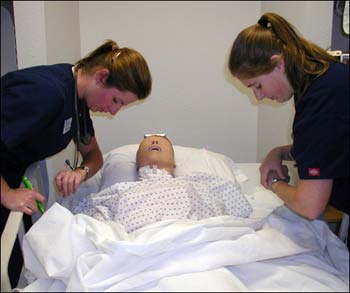The words “he’s stopped breathing” cause nursing students at Northern Arizona University to scramble to their patient’s side. They administer emergency procedures to revive him, and although he starts breathing again, he still isn’t alive.
He’s a SimMan, an advanced training mannequin designed to simulate a live human so nursing students can practice real-life skills in a safe environment.
This is no ordinary classroom. Made to replicate an actual hospital ward, curtains drape around five beds. Monitors blink, oxygen pumps and fluids flow into patients that upon closer look are mannequins mimicking symptoms from a variety of illnesses, wounds and other trauma scenarios that come up in real life.
Sophomore nursing student Heather Helms, dressed in blue scrubs, scurries around her “Sim.” The chest rises and falls with fake breaths. Helms takes the pulse and some other vitals, records data in SimMan’s medical chart and confers with the rest of her team on what care to provide.
|
“Sometimes it’s easy to forget they are not real. They bleed and they can even talk to us,” Helms said. “Practicing on a simulator builds my confidence for when I have to do an actual procedure.”
Depending on the scenario, SimMan can talk, moan, laugh or cry. Computer software allows a controller to create different traumas as well as assess the care it gets.
According to Gina Long, associate director of NAU’s School of Nursing, simulations teach students to recognize the different things that can happen with a patient.
“You can listen to him like you would a regular patient. His chest can rise and fall and students can hear lung sounds, heart sounds, bowel sounds and feel his pulse,” Long said. “In real-life you have to work at a different pace. Here students can take their time and simulate a real-life situation until they feel comfortable doing a given procedure or completing assessments. Then, when they are in a clinical setting, they feel more prepared to do things in a ‘real world’ pace.”
Long said confidence is what SimMan teaches best. “By simulating reality, students are really getting it,” she said. “Lots of students concentrate on what they could have done differently. We often have to remind them of what they did right.”
Long said NAU is one of a growing number nursing programs in the country to offer this quality of interactive training experience, and the School of Nursing is gearing up to share the learning experience with others.
NAU has five portable, advanced simulators for team training. Two are used in the nursing department’s Simulated Learning Center: two support training at distance learning sites in Tucson and St. Michaels, and its newest SimMan, nestled in its box, will soon move to its new home at Flagstaff Medical Center.
Long said NAU will provide the SimMan, and the medical center will provide the space for on-site training as well as the peripheral equipment needed for reenacting different patient care scenarios.
The university has a total of 16 simulators, and six are the advanced kind costing about $50,000 each. Other simulators on the Flagstaff campus include two babies, two children and two adults. The Tucson and St. Michael’s sites also each have another adult mannequin as well as a simulated child and infant.
For information, go to www.nau.edu/nursing/.



